Rabbit
| Rabbit Temporal range: Late Eocene-Holocene, 53–0 Ma | |
|---|---|
 | |
| Young rabbit in Montana, United States | |
| Scientific classification | |
| Kingdom: | Animalia |
| Phylum: | Chordata |
| Subphylum: | Vertebrata |
| Class: | Mammalia |
| Order: | Lagomorpha |
| Family: | Leporidae in part |
| Genera | |
Rabbits are small mammals in the family Leporidae of the order Lagomorpha, found in several parts of the world. There are eight different genera in the family classified as rabbits, including the European rabbit (Oryctolagus cuniculus), cottontail rabbits (genus Sylvilagus; 13 species), and the Amami rabbit (Pentalagus furnessi, an endangered species on Amami Ōshima, Japan). There are many other species of rabbit, and these, along with pikas and hares, make up the order Lagomorpha. The male is called a buck and the female is a doe; a young rabbit is a kitten or kit.
Habitat and range
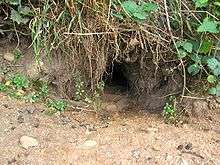
Rabbit habitats include meadows, woods, forests, grasslands, deserts and wetlands.[1] Rabbits live in groups, and the best known species, the European rabbit, lives in underground burrows, or rabbit holes. A group of burrows is called a warren.[1]
More than half the world's rabbit population resides in North America.[1] They are also native to southwestern Europe, Southeast Asia, Sumatra, some islands of Japan, and in parts of Africa and South America. They are not naturally found in most of Eurasia, where a number of species of hares are present. Rabbits first entered South America relatively recently, as part of the Great American Interchange. Much of the continent has just one species of rabbit, the tapeti, while most of South America's southern cone is without rabbits.
The European rabbit has been introduced to many places around the world.[2]
Terminology
Male rabbits are called bucks; females are called does. An older term for an adult rabbit is coney, while rabbit once referred only to the young animals.[3] Another term for a young rabbit is bunny, though this term is often applied informally (especially by children) to rabbits generally, especially domestic ones. More recently, the term kit or kitten has been used to refer to a young rabbit. A young hare is called a leveret; this term is sometimes informally applied to a young rabbit as well.
A group of rabbits is known as a colony, or nest (and occasionally a warren, though this more commonly refers to where the rabbits live).[4] A group of young rabbits with the same parentage is referred to as a litter, and a group of domestic rabbits is sometimes called a herd.[5]
Biology

Evolution
Because the rabbit's epiglottis is engaged over the soft palate except when swallowing, the rabbit is an obligate nasal breather. Rabbits have two sets of incisor teeth, one behind the other. This way they can be distinguished from rodents, with which they are often confused.[6] Carl Linnaeus originally grouped rabbits and rodents under the class Glires; later, they were separated as the scientific consensus is that many of their similarities were a result of convergent evolution. However, recent DNA analysis and the discovery of a common ancestor has supported the view that they share a common lineage, and thus rabbits and rodents are now often referred to together as members of the superorder Glires.[7]
Morphology

.jpg)
The rabbit's long ears, which can be more than 10 cm (4 in) long, are probably an adaptation for detecting predators. They have large, powerful hind legs. The two front paws have 5 toes, the extra called the dewclaw. The hind feet have 4 toes.[8] They are plantigrade animals while at rest; however, they move around on their toes while running, assuming a more digitigrade form. Unlike some other paw structures of quadruped mammals, especially those of domesticated pets, rabbit paws lack pads. Their nails are strong and are used for digging; along with their teeth, they are also used for defense.
Wild rabbits do not differ much in their body proportions or stance, with full, egg-shaped bodies. Their size can range anywhere from 20 cm (8 in) in length and 0.4 kg in weight to 50 cm (20 in) and more than 2 kg. The fur is most commonly long and soft, with colors such as shades of brown, gray, and buff. The tail is a little plume of brownish fur (white on top for cottontails).[2] Rabbits can see nearly 360 degrees, with a small blind spot at the bridge of the nose.[9]
Ecology
Rabbits are hindgut digesters. This means that most of their digestion takes place in their large intestine and cecum. In rabbits, the cecum is about 10 times bigger than the stomach and it along with the large intestine makes up roughly 40% of the rabbit's digestive tract.[10] The unique musculature of the cecum allows the intestinal tract of the rabbit to separate fibrous material from more digestible material; the fibrous material is passed as feces, while the more nutritious material is encased in a mucous lining as a cecotrope. Cecotropes, sometimes called "night feces", are high in minerals, vitamins and proteins that are necessary to the rabbit's health. Rabbits eat these to meet their nutritional requirements; the mucous coating allows the nutrients to pass through the acidic stomach for digestion in the intestines. This process allows rabbits to extract the necessary nutrients from their food.[11]
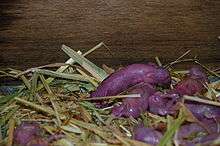
Rabbits are prey animals and are therefore constantly aware of their surroundings. For instance, in Mediterranean Europe, rabbits are the main prey of red foxes, badgers, and Iberian lynxes.[12] If confronted by a potential threat, a rabbit may freeze and observe then warn others in the warren with powerful thumps on the ground. Rabbits have a remarkably wide field of vision, and a good deal of it is devoted to overhead scanning.[13] They survive predation by burrowing, hopping away in a zig-zag motion, and, if captured, delivering powerful kicks with their hind legs. Their strong teeth allow them to eat and to bite in order to escape a struggle.[14] The longest-lived rabbit on record, a domesticated European rabbit living in Tasmania, died at age 18.[15] The lifespan of wild rabbits is much shorter; the average longevity of an eastern cottontail, for instance, is less than one year.[16]
Sleep
Rabbits are crepuscular, most active at dawn and dusk. The average sleep time of a rabbit in captivity is said to be 8.4 hours.[17] As with other prey animals, rabbits often sleep with their eyes open so sudden movements will wake the rabbit and alert it to dangers.[18]
Diet and eating habits
Rabbits are herbivores that feed by grazing on grass, forbs, and leafy weeds. In consequence, their diet contains large amounts of cellulose, which is hard to digest. Rabbits solve this problem via a form of hindgut fermentation. They pass two distinct types of feces: hard droppings and soft black viscous pellets, the latter of which are known as caecotrophs and are immediately eaten (a behaviour known as coprophagy). Rabbits reingest their own droppings (rather than chewing the cud as do cows and numerous other herbivores) to digest their food further and extract sufficient nutrients.[19]
Rabbits graze heavily and rapidly for roughly the first half-hour of a grazing period (usually in the late afternoon), followed by about half an hour of more selective feeding. In this time, the rabbit will also excrete many hard fecal pellets, being waste pellets that will not be reingested. If the environment is relatively non-threatening, the rabbit will remain outdoors for many hours, grazing at intervals. While out of the burrow, the rabbit will occasionally reingest its soft, partially digested pellets; this is rarely observed, since the pellets are reingested as they are produced. Reingestion is most common within the burrow between 8 o'clock in the morning and 5 o'clock in the evening, being carried out intermittently within that period.
Hard pellets are made up of hay-like fragments of plant cuticle and stalk, being the final waste product after redigestion of soft pellets. These are only released outside the burrow and are not reingested. Soft pellets are usually produced several hours after grazing, after the hard pellets have all been excreted. They are made up of micro-organisms and undigested plant cell walls.
The chewed plant material collects in the large cecum, a secondary chamber between the large and small intestine containing large quantities of symbiotic bacteria that help with the digestion of cellulose and also produce certain B vitamins. The pellets are about 56% bacteria by dry weight, largely accounting for the pellets being 24.4% protein on average. The soft feces form here and contain up to five times the vitamins of hard feces. After being excreted, they are eaten whole by the rabbit and redigested in a special part of the stomach. The pellets remain intact for up to six hours in the stomach; the bacteria within continue to digest the plant carbohydrates. This double-digestion process enables rabbits to use nutrients that they may have missed during the first passage through the gut, as well as the nutrients formed by the microbial activity and thus ensures that maximum nutrition is derived from the food they eat.[2] This process serves the same purpose within the rabbit as rumination does in cattle and sheep.[20]
Rabbits are incapable of vomiting.[21]
Rabbit diseases
Rabbits can be affected by a number of diseases. These include pathogens that also affect other animals and/or humans, such as Bordetella bronchiseptica and Escherichia coli, as well as diseases unique to rabbits such as rabbit haemorrhagic disease: a form of calicivirus,[22] and myxomatosis.
Rabbits and hares are almost never found to be infected with rabies and have not been known to transmit rabies to humans.[23]
Among the parasites that infect rabbits are tapeworms such as Taenia serialis, external parasites like fleas and mites, coccidia species, and Toxoplasma gondii.[24][25]
Differences from hares
The most obvious difference between rabbits and hares is how their kits are born. Rabbits are altricial, having young that are born blind and hairless. In contrast, hares are precocial, born with hair and good vision. All rabbits except cottontail rabbits live underground in burrows or warrens, while hares live in simple nests above the ground (as do cottontail rabbits), and usually do not live in groups. Hares are generally larger than rabbits, with longer ears, larger and longer hind legs and have black markings on their fur. Hares have not been domesticated, while European rabbits are both raised for meat and kept as pets.
Domesticated rabbits

The only rabbit to be widely domesticated is the European rabbit, which has been extensively bred for food and later as a pet. It was first widely kept in ancient Rome and has been refined into a wide variety of breeds during and since the Middle Ages.
Domesticated rabbits have mostly been bred to be much larger than wild rabbits, though selective breeding has produced a range of sizes from dwarf to giant, which are kept as pets and food animals across the world. They have as much colour variation among themselves as other livestock and pet animals. Their fur is prized for its softness; today, Angora rabbits are raised for their long, soft fur, which is often spun into yarn. Other breeds are raised for the fur industry, particularly the Rex, which has a smooth, velvet-like coat and comes in a wide variety of colors and sizes.
As food and clothing


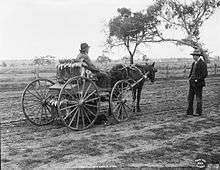

Leporids such as European rabbits and hares are a food meat in Europe, China, South America, North America, some parts of the Middle East. By some estimates, world's annual rabbit meat production stands at around 200 million tons.[26]
Rabbit is sold in UK butchers and markets, and some supermarkets sell frozen rabbit meat. Additionally, some have begun selling fresh rabbit meat alongside other types of game. At farmers markets and the famous Borough Market in London, rabbits will be displayed dead and hanging unbutchered in the traditional style next to braces of pheasant and other small game. The countries where rabbit meat consumption is highest are Malta (8.89 kg per inhabitant), Italy (5.71 kg per inhabitant), Cyprus (4.37 kg per inhabitant), France (2.76 kg per inhabitant), Belgium (2.73 kg per inhabitant), Spain (2.61 kg per inhabitant) and Portugal (1.94 kg per inhabitant).[27]
Rabbit meat was once commonly sold in Sydney, Australia, the sellers of which giving the name to the rugby league team the South Sydney Rabbitohs, but it quickly became unpopular after the disease myxomatosis was introduced in an attempt to wipe out the country's large feral rabbit population. Rabbit meat is also commonly used in Moroccan cuisine, where it is cooked in a tajine with "raisins and grilled almonds added a few minutes before serving".[28]
In China, rabbit meat is particularly popular in Sichuan cuisine. Among popular dishes are stewed rabbit, spicy diced rabbit, BBQ-style rabbit, and even spicy rabbit heads, which have been compared to the duck neck.[26] Rabbit meat is comparably unpopular elsewhere in the Asia-Pacific.
When used for food, rabbits are both hunted and bred for meat. Snares or guns are usually employed when catching wild rabbits for food. In many regions, rabbits are also bred for meat, a practice called cuniculture. Rabbits can then be killed by hitting the back of their heads, a practice from which the term rabbit punch is derived. Rabbit meat is a source of high quality protein.[29] It can be used in most ways chicken meat is used. In fact, well-known chef Mark Bittman says that domesticated rabbit tastes like chicken because both are blank palettes upon which any desired flavors can be layered.[30] Rabbit meat is leaner than beef, pork, and chicken meat. Rabbit products are generally labeled in three ways, the first being Fryer. This is a young rabbit between 2.0 and 2.3 kilograms (4.5 and 5 lb) and up to 9 weeks in age.[31] This type of meat is tender and fine grained. The next product is a Roaster; they are usually over 2.3 kilograms (5 lb) and up to 8 months in age. The flesh is firm and coarse grained and less tender than a fryer. Then there are giblets which include the liver and heart. One of the most common types of rabbit to be bred for meat is New Zealand white rabbit. The largest rabbit meat producing countries (100,000 tons or more per year) are China, Russia, Italy, France and Spain.[27]
In efficient production systems, rabbits can turn 20 percent of the proteins they eat into edible meat, compared to 22 to 23 percent for broiler chickens, 16 to 18 percent for pigs and 8 to 12 percent for beef; rabbit meat is more economical in terms of feed energy than beef.[27]
Compared with the meat of other species (especially pork and beef), rabbit meat is richer in proteins and certain vitamins and minerals, while it has less fat; rabbit fat contains less stearic and oleic acids than other species and higher proportions of the essential polyunsaturated linolenic and linoleic fatty acids.[27] The main health issues associated with the use of rabbits for meat are tularemia or rabbit fever which is an infection that may be contracted from close contact with rabbits[32] and the so-called rabbit starvation. Rabbit starvation is most likely due to the deficiency of fat in rabbit meat. In comparison, pemmican is a meat-based food that is nutritionally complete but is composed of dry meat fibers and fat in a 1:1 ratio by weight. Rabbit starvation is similar to other metabolic issues that arise in times of extreme starvation. An analogous condition (though with different symptoms) occurs when carbohydrates are ingested in the absence of fat and protein.[33] These conditions are not well-documented by Western medicine because such total absence of fat and protein are relatively rare and not likely to occur where medical attention is available. However, a slim variety of historical writings refer to rabbit starvation, for example, Vilhjamur Stefansson in the late 19th century, and in the journals of Charles Darwin.
Rabbit pelts are sometimes used for clothing and accessories, such as scarves or hats. Angora rabbits are bred for their long, fine hair, which can be sheared and harvested like sheep wool. Rabbits are very good producers of manure; additionally, their urine, being high in nitrogen, makes lemon trees very productive. Their milk may also be of great medicinal or nutritional benefit due to its high protein content.[34]
Environmental problems
Rabbits have been a source of environmental problems when introduced into the wild by humans. As a result of their appetites, and the rate at which they breed, feral rabbit depredation can be problematic for agriculture. Gassing, barriers (fences), shooting, snaring, and ferreting have been used to control rabbit populations, but the most effective measures are diseases such as myxomatosis (myxo or mixi, colloquially) and calicivirus. In Europe, where rabbits are farmed on a large scale, they are protected against myxomatosis and calicivirus with a genetically modified virus. The virus was developed in Spain, and is beneficial to rabbit farmers. If it were to make its way into wild populations in areas such as Australia, it could create a population boom, as those diseases are the most serious threats to rabbit survival. Rabbits in Australia and New Zealand are considered to be such a pest that land owners are legally obliged to control them.[35][36]
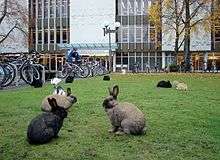
In culture and literature
Rabbits are often used as a symbol of fertility or rebirth, and have long been associated with spring and Easter as the Easter Bunny. The species' role as a prey animal also lends itself as a symbol of innocence, another Easter connotation. They appear in folklore and modern children's stories, often but not invariably as sympathetic characters.
Additionally, rabbits are often used as symbols of playful sexuality, which also relates to the human perception of innocence, as well as its reputation as a prolific breeder.
Folklore and mythology
The rabbit often appears in folklore as the trickster archetype, as he uses his cunning to outwit his enemies.
- In Aztec mythology, a pantheon of four hundred rabbit gods known as Centzon Totochtin, led by Ometotchtli or Two Rabbit, represented fertility, parties, and drunkenness.
- In Central Africa, the common hare (Kalulu), is "inevitably described" as a trickster figure.[37]
- In Chinese folklore, rabbits accompany Chang'e on the Moon. Also associated with the Chinese New Year (or Lunar New Year), rabbits are also one of the twelve celestial animals in the Chinese Zodiac for the Chinese calendar. It is interesting to note that the Vietnamese lunar new year replaced the rabbit with a cat in their calendar, as rabbits did not inhabit Vietnam.
- A rabbit's foot is carried as an amulet believed to bring good luck. This is found in many parts of the world, and with the earliest use being in Europe around 600 B.C.[38]
- In Japanese tradition, rabbits live on the Moon where they make mochi, the popular snack of mashed sticky rice. This comes from interpreting the pattern of dark patches on the moon as a rabbit standing on tiptoes on the left pounding on an usu, a Japanese mortar (See also: Moon rabbit).
- In Jewish folklore, rabbits (shfanim שפנים) are associated with cowardice, a usage still current in contemporary Israeli spoken Hebrew (similar to English colloquial use of "chicken" to denote cowardice).
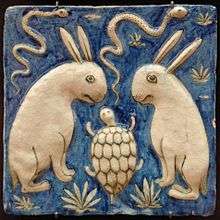
- In Korean mythology, as in Japanese, rabbits live on the moon making rice cakes (Tteok in Korean).
- In Anishinaabe traditional beliefs, held by the Ojibwe and some other Native American peoples, Nanabozho, or Great Rabbit, is an important deity related to the creation of the world.
- Among English speakers, the rabbit may be invoked at the start of the month out of apotropaic or talismanic superstition.
- A Vietnamese mythological story portrays the rabbit of innocence and youthfulness. The Gods of the myth are shown to be hunting and killing rabbits to show off their power.
On the Isle of Portland in Dorset, UK, the rabbit is said to be unlucky and speaking its name can cause upset with older residents. This is thought to date back to early times in the quarrying industry, where piles of extracted stone (not fit for sale) were built into tall rough walls (to save space) directly behind the working quarry face; the rabbit's natural tendency to burrow would weaken these "walls" and cause collapse, often resulting in injuries or even death. The name rabbit is often substituted with words such as “long ears” or “underground mutton”, so as not to have to say the actual word and bring bad luck to oneself. It is said that a public house (on the island) can be cleared of people by calling out the word rabbit and while this was very true in the past, it has gradually become more fable than fact over the past 50 years. See also Three hares.
Other fictional rabbits
The rabbit as trickster appears in American popular culture; for example the Br'er Rabbit character from African-American folktales and Disney animation; and the Warner Bros. cartoon character Bugs Bunny.
Anthropomorphized rabbits have appeared in a host of works of film, literature, and technology, notably the White Rabbit and the March Hare in Lewis Carroll's Alice's Adventures in Wonderland; in the popular novels Watership Down, by Richard Adams, along with its film and television adaptations, Rabbit Hill by Robert Lawson, as well as in Beatrix Potter's Peter Rabbit stories, and Oswald the Lucky Rabbit, a 1920s cartoon character.
Urban legends
It was commonly believed that pregnancy tests were based on the idea that a rabbit would die if injected with a pregnant woman's urine. This is not true. However, in the 1920s it was discovered that if the urine contained the hCG, a hormone found in the bodies of pregnant women, the rabbit would display ovarian changes. The rabbit would then be killed to have its ovaries inspected, but the death of the rabbit was not the indicator of the results. Later revisions of the test allowed technicians to inspect the ovaries without killing the animal. A similar test involved injecting Xenopus frogs to make them lay eggs, but animal tests for pregnancy have been made obsolete by faster, cheaper, and simpler modern methods.
Classifications
| Wikimedia Commons has media related to Rabbit breeds. |
Rabbits and hares were formerly classified in the order Rodentia (rodent) until 1912, when they were moved into a new order Lagomorpha. This order also includes pikas.
Order Lagomorpha
- Family Leporidae
- Genus Pentalagus
- Amami rabbit/Ryūkyū rabbit, Pentalagus furnessi
- Genus Bunolagus
- Bushman rabbit, Bunolagus monticularis
- Genus Nesolagus
- Sumatran striped rabbit, Nesolagus netscheri
- Annamite striped rabbit, Nesolagus timminsi
- Genus Romerolagus
- Volcano rabbit, Romerolagus diazi
- Genus Brachylagus
- Pygmy rabbit, Brachylagus idahoensis
- Genus Sylvilagus
- Forest rabbit, Sylvilagus brasiliensis
- Dice's cottontail, Sylvilagus dicei
- Brush rabbit, Sylvilagus bachmani
- San Jose brush rabbit, Sylvilagus mansuetus
- Swamp rabbit, Sylvilagus aquaticus
- Marsh rabbit, Sylvilagus palustris
- Eastern cottontail, Sylvilagus floridanus
- New England cottontail, Sylvilagus transitionalis
- Mountain cottontail, Sylvilagus nuttallii
- Desert cottontail, Sylvilagus audubonii
- Omilteme cottontail, Sylvilagus insonus
- Mexican cottontail, Sylvilagus cunicularis
- Tres Marias rabbit, Sylvilagus graysoni
- Genus Oryctolagus
- European rabbit, Oryctolagus cuniculus
- Genus Poelagus
- Central African Rabbit, Poelagus marjorita
- Three other genera in family, regarded as hares, not rabbits
- Genus Pentalagus
See also
References
- 1 2 3 "Rabbit Habitats". Retrieved 7 July 2009.
- 1 2 3 "rabbit". Encyclopædia Britannica (Standard ed.). Chicago: Encyclopædia Britannica, Inc. 2007.
- ↑ Online Etymology Dictionary
- ↑ "The Collective Noun Page". Retrieved 2008-01-30.
- ↑ "Common Questions: What Do You Call a Group of...?". archived copy of Animal Congregations, or What Do You Call a Group of.....?. U.S. Geological Survey Northern Prairie Wildlife Research Center. Archived from the original on 20 March 2015. Retrieved 2015-04-13.
- ↑ Brown, Louise (2001). How to Care for Your Rabbit. Kingdom Books. p. 6. ISBN 978-1-85279-167-4.
- ↑ Katherine Quesenberry & James W. Carpenter, Ferrets, Rabbits, and Rodents: Clinical Medicine and Surgery (3rd ed. 2011).
- ↑ "Rabbits: Rabbit feet". Retrieved 13 July 2010.
- ↑ http://www.bio.miami.edu/hare/vision.html?1
- ↑ "Feeding the Pet Rabbit"
- ↑ Dr. Byron de la Navarre's "Care of Rabbits" Susan A. Brown, DVM's "Overview of Common Rabbit Diseases: Diseases Related to Diet"
- ↑ Fedriani, J. M.; Palomares, F.; Delibes, M. (1999). "Niche relations among three sympatric Mediterranean carnivores" (PDF). Oecologia. 121: 138–148. doi:10.1007/s004420050915. JSTOR 4222449.
- ↑ Tynes, Valarie V. Behavior of Exotic Pets. Wiley Blackwell, 2010, p. 70
- ↑ Davis, Susan E. and DeMello, Margo Stories Rabbits Tell: A Natural And Cultural History of A Misunderstood Creature. Lantern Books, 2003, p. 27.
- ↑ Glenday, Craig (2013). Guinness World Records 2014. p. 043. ISBN 978-1-908843-15-9.
- ↑ Cottontail rabbit at Indiana Department of Natural Resources
- ↑ "40 Winks?" Jennifer S. Holland, National Geographic Vol. 220, No. 1. July 2011.
- ↑ Wright, Samantha (2011). For The Love of Parsley. A Guide To Your Rabbit's Most Common Behaviours. Lulu. pp. 35–36. ISBN 1-4467-9111-4.
- ↑ "Information for Rabbit Owners — Oak Tree Veterinary Centre". Oaktreevet.co.uk. Archived from the original on 2012-06-23. Retrieved 30 August 2010.
- ↑ The Private Life of the Rabbit, R. M. Lockley, 1964. Chapter 10.
- ↑ "True or False? Rabbits are physically incapable of vomiting. (Answer to Pop Quiz)".
- ↑ Cooke, Brian Douglas (2014). Australia's War Against Rabbits. CSIRO Publishing. ISBN 978-0-643-09612-7.
- ↑ "Rabies: Other Wild Animals". Centers for Disease Control and Prevention. 15 November 2011. Retrieved 20 December 2012.
- ↑ Wood, Maggie. "Parasites of Rabbits". Chicago Exotics, PC. Retrieved 8 April 2013.
- ↑ Boschert, Ken. "Internal Parasites of Rabbits". Net Vet. Retrieved 8 April 2013.
- 1 2 Olivia Geng, French Rabbit Heads: The Newest Delicacy in Chinese Cuisine. The Wall Street Journal Blog, 13 June 2014
- 1 2 3 4 FAO - The Rabbit - Husbandry, health and production.
- ↑ 'Traditional Moroccan Cooking, Recipes from Fez', by Madame Guinadeau. (Serif, London, 2003). ISBN 1-897959-43-5.
- ↑ "Rabbit: From Farm to Table".
- ↑ "How to Cook Everything :: Braised Rabbit with Olives". 2008. Archived from the original on 17 May 2008. Retrieved 17 July 2008.
- ↑ Sell, Randy Rabbit. North Dakota Department of Agricultural Economics.
- ↑ "Tularemia (Rabbit fever)". Health.utah.gov. 16 June 2003. Retrieved 30 August 2010.
- ↑ " "Cassava root causes cognitive damage in Congolese villages". National Institutes of Health, Fogarty International Center. Feb 2014.
- ↑ Houdebine, Louis-Marie; Fan, Jianglin (1 June 2009). Rabbit Biotechnology: Rabbit Genomics, Transgenesis, Cloning and Models. シュプリンガー・ジャパン株式会社. pp. 68–72. ISBN 978-90-481-2226-4. Retrieved 8 October 2010.
- ↑ "Feral animals in Australia — Invasive species". Environment.gov.au. 1 February 2010. Retrieved 30 August 2010.
- ↑ "Rabbits — The role of government — Te Ara Encyclopedia of New Zealand". Teara.govt.nz. 1 March 2009. Retrieved 30 August 2010.
- ↑ Brian Morris, The Power of Animals: An Ethnography, p. 177 (2000).
- ↑ Ellis, Bill: Lucifer Ascending: The Occult in Folklore and Popular Culture (University of Kentucky, 2004) ISBN 0-8131-2289-9
Further reading
- Windling, Terri. The Symbolism of Rabbits and Hares
External links
| Wikimedia Commons has media related to Rabbit. |
| Wikiquote has quotations related to: Rabbit |
- American Rabbit Breeders Association organization which promotes all phases of rabbit keeping
- House Rabbit Society an activist organization which promotes keeping rabbits indoors.
- RabbitShows.com an informational site on the hobby of showing rabbits.
- The (mostly) silent language of rabbits
- World Rabbit Science Association an international rabbit-health science-based organization
- The Year of the Rabbit – slideshow by Life magazine
- House Rabbit Society- FAQ: Aggression